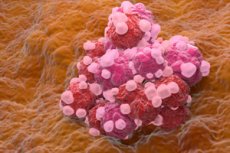Nye publikasjoner
Kjemoterapi mot glioblastom forbedres ved å utnytte døgnrytmen i cellene
Sist anmeldt: 02.07.2025

Alt iLive-innhold blir gjennomgått med medisin eller faktisk kontrollert for å sikre så mye faktuell nøyaktighet som mulig.
Vi har strenge retningslinjer for innkjøp og kun kobling til anerkjente medieområder, akademiske forskningsinstitusjoner og, når det er mulig, medisinsk peer-evaluerte studier. Merk at tallene i parenteser ([1], [2], etc.) er klikkbare koblinger til disse studiene.
Hvis du føler at noe av innholdet vårt er unøyaktig, utdatert eller ellers tvilsomt, velg det og trykk Ctrl + Enter.

Glioblastom er en aggressiv form for hjernekreft som det ikke finnes noen kur for. En nylig studie av pasientjournaler for glioblastom fant at det å ta cellegift om morgenen var assosiert med en økning i median overlevelse på tre til seks måneder.
Nå rapporterer en studie fra Washington University i St. Louis at glioblastomceller har innebygde døgnrytmer som skaper gunstigere tidspunkter for behandling.
Biologer og klinikere har dokumentert døgnrytmer i uttrykket av "klokkegener" fra ulike dyrkede cellelinjer og isolater av humant og museglioblastom. Disse rytmene sammenfaller med døgnrytmen til et DNA-reparasjonsenzym kjent som MGMT.
Forskerne utførte deretter tester og fant at tumorceller hadde større sannsynlighet for å dø når cellegift ble gitt på et tidspunkt på dagen – om morgenen – da tumorcellene hadde minst MGMT-aktivitet.
Forskerne gjentok arbeidet sitt på mus med glioblastom, og fant at morgenadministrasjon av cellegift reduserte tumorstørrelsen og økte kroppsvekten sammenlignet med kveldsadministrasjon av legemidlet.
«Det kan være en mulighet til å behandle denne sykdommen bedre med et legemiddel på tider av døgnet når cellene er mer mottakelige», sa Maria F. Gonzalez-Aponte, en biologistudent ved University of Washingtons College of Arts and Sciences, som er førsteforfatter av den nye studien.
«Vi fant at subjektiv morgenadministrasjon av cellegift med temozolomid (TMZ) kan redusere tumorvekst betydelig og forbedre behandlingsresultatene i glioblastommodeller hos mennesker og mus.»
«Fordi TMZ tas oralt hjemme, er det relativt enkelt å oversette disse resultatene til pasienter», sa Eric D. Herzog, Ph.D., Victor Hamburger Distinguished Service Professor og professor i biologi ved College of Arts and Sciences, korresponderende forfatter av den nye studien.
«Vi trenger ytterligere kliniske studier for å bekrefte våre laboratoriefunn, men nåværende data tyder på at standardbehandling for glioblastom kan forbedres ganske enkelt ved å be pasientene ta et godkjent legemiddel om morgenen», sa Herzog.
Selv om praksisen med behandling på døgnet har blitt lite studert for TMZ og glioblastom, bemerket forfatterne av studien at det har vist seg å forbedre resultatene i flere krefttyper, inkludert akutt lymfatisk leukemi, kolorektal, eggstokkreft og andre gynekologiske kreftformer.
Joshua B. Rubin, MD, Ph.D., professor i pediatri og nevrovitenskap ved medisinstudiet, en mangeårig samarbeidspartner i Herzogs laboratorium og medforfatter av artikkelen. Gary J. Patti, Ph.D., professor i kjemi ved College of Arts and Sciences og of Medicine ved medisinstudiet, og postdoktor Kevin Cho, Ph.D., i kjemi, er også medforfattere.
Funnene i denne studien har implikasjoner for både behandling og diagnose av glioblastom.
Generelt sett responderer glioblastompasienter som får diagnosen såkalte MGMT-metylerte svulster bedre på TMZ-holdig cellegiftbehandling.
Men denne studien viste at MGMT-metyleringsnivåene stiger og faller avhengig av svulstens døgnrytme. Som et resultat må leger vurdere tidspunktet på dagen når tumorbiopsier tas for å kunne sammenligne resultater på riktig måte og forbedre diagnostikken, bemerket forfatterne av studien.
«Til tross for omfattende forskning de siste 20 årene, er median overlevelse for glioblastompasienter etter behandling fortsatt på omtrent 15 måneder, noe som er en dyster statistikk», sa Herzog. «Innføring av kromoterapi, eller rettidig administrering av legemidler, kan bidra til å forbedre situasjonen.»
Studien er publisert i Journal of Neuro-Oncology.
